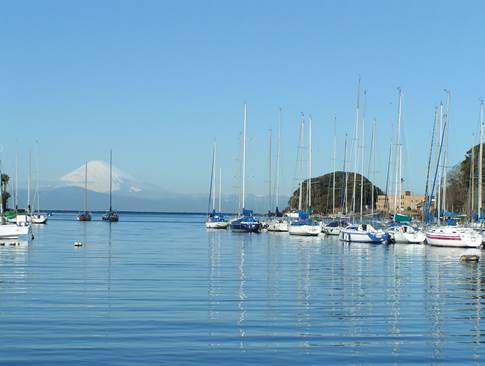Misaki Marine Biological Station
School of Science
The University of Tokyo
Contact
Dr. Manabu Yoshida
yoshida@mmbs.s.u-tokyo.ac.jp
Phone: +81 46 881 4105
Address
Misaki Marine Biological Station
School of Science, University of Tokyo
1024 Koajiro, Misaki
Miura
Kanagawa 238-0225 (Japan)
Group Description
Misaki Marine Biological Station (MMBS), Graduate School of Science, the University of Tokyo, is located at the southwestern tip of the Miura Peninsula of Kanagawa Prefecture. To take advantage of the especially rich fauna in the surrounding for research, MMBS was founded in 1886 in Misaki to make it one of the oldest marine stations in the world. As a joint usage / research center, we are promoting advanced biological research and next generation research. A total of 30,000 researchers and students use our station each year.
MMBS is a cooperative member of the Department of Biological Sciences, Graduate School and Faculty of Science, the University of Tokyo, and provide marine biology training courses for undergraduate students and supervise graduate school studies. We also offer training courses of marine biology during summer and spring vacations, open also to other university students.
Main Lines of Research
– Mechanisms of Sperm Activation and Chemotaxis:
Activation of the sperm motility and chemotactic behavior of sperm toward eggs are the first communication between sperm and eggs at fertilization. We have determined the molecular structure of SAAFs, the sperm-activating and attracting factor of the ascidians (Urochodata) Ciona intestinalis and Ascidia sydneiensis. Now we are analyzing the molecular mechanisms of sperm activation and chemotaxis, especially molecular basis of species specificity.
We also study on molecular mechanisms of sperm activation on teleosts sperm.
– Capacitation of Mammalian Sperm:
Mammalian sperm can not fertilize with an egg just after ejaculation, and capacitated in the female genital tract. On the other hand, some factors in the seminal plasma is involved in sperm capacitation. We are studying the role of a seminal plasma in sperm capacitation.
Links
Misaki Marine Biological Station: http://www.mmbs.s.u-tokyo.ac.jp/en/index.html
Facebook Page: Yoshida Group, MMBS: https://www.facebook.com/MMBS.YoshidaLab?ref=hl
Relevant publications
1. Araki, N., Trencsenyi, G., Krasznai, Z. T., Nizsaloczki, E., Sakamoto, A., Kawano, N., Miyado, K., Yoshida, K., and Yoshida, M. Seminal vesicle secretion 2 acts as a protectant of sperm sterols and prevents ectopic sperm capacitation. Biology of Reproduction (2014) in press.
2. Gallego, V., Pérez, L., Asturiano, J. F., and Yoshida, M. Sperm motility parameters and spermatozoa morphometric characterization in marine species: a study of swimmer and sessile species. Theriogenology 82 (5): 668-676 (2014).
3. Kawano, N., Araki, N., Yoshida, K., Hibino, T., Ohnami, N., Makino, M., Kanai S., Hasuwa, H., Yoshida, M., Miyado, K., and Umezawa, A. Seminal vesicle protein SVS2 is required for sperm survival in the uterus Proceedings of the National Academy Sciences USA, 111 (11), 4145-4150 (2014).
4. Gallego, V., Pérez, L., Asturiano, J. F., and Yoshida, M. Study of puffer fish (Takifugu niphobles) sperm: development of methods for short-term storage, effect of different activation role of intracellular changes in Ca2+ and K+ in the initiation motility. Aquaculture 414-415: 82-91(2013).
5. Gallego, V., Pérez, L., Asturiano, J. F., and Yoshida, M. Relationship between spermatozoa motility parameters, sperm/egg ratio, fertilization success and hatching rates in the puffer fish (Takifugu niphobles). Aquaculture 416–417: 238-243 (2013).
6. Matsumori, N., Hiradate, Y., Shibata, H., Oishi, T., Simma, S., Toyoda, M., Hayashi, F., Yoshida, M, Murata, M, and Morisawa, M. A Novel Sperm-Activating and Attracting Factor (SAAF) from the Ascidian Ascidia sydneiensis. Organic Letters, 15 (2), 294-297 (2013).
7. Yoshida, M., Hiradate, Y, Sensui, N., Cosson, J., and Morisawa, M. Species-specificity of sperm motility activation and chemotaxis: a study on ascidian species. Biological Bulletin, 224 (3), 156-165 (2013).
8. Sensui, N., Yoshida, M. and Tachibana, K. Role of Mos/MEK/ERK cascade and Cdk1 in Ca2+ oscillations in fertilized ascidian eggs. Developmental Biology 367, 208-215 (2012).
9. Yoshida M., and Yoshida, K. Sperm chemotaxis and regulation of flagellar movement by Ca2+ Molecular Human Reproduction 17, 457-465 (2011).
10. Kawano, N., Ito, J., Kashiwazaki, N., and Yoshida, M. Phosphorylation of the MAPK pathway has an essential role in the acrosome reaction in miniature pig sperm. Reproduction in Domestic Animals, 45, 263-268 (2010).
11. Kowalski, R.K., Shiba, K., Yoshida, M. and Glogowski, J. Prostaglandins in rainbow trout (Oncorhynchus mykiss WALBAUM, 1792) sperm biology − searching for answers. Journal of Applied Ichthyology, 24, 487-491 (2008).
12. Kondoh, E., Konno, A., Inaba, K., Oishi, T., Murata, M., and Yoshida, M. Valosin-containing protein/p97 interacts with sperm-activating and sperm-attracting factor (SAAF) in the ascidian egg and modulates sperm-attracting activity. Development Growth & Differentiation, 50, 665-673 (2008).
13. Yoshida, M., Yoshida, K., Shiba, K., Tsuchikawa, H., Ootou, O., Oishi, T. and Murata, M. Ascidian sperm activating and attracting factor: Importance of sulfate groups for the activities and implication of its putative receptor. FEBS letters, 582, 3429-3433 (2008).
14. Kawano, N., Yoshida, K., Iwamoto, T. and Yoshida, M. Ganglioside GM1 mediates decapacitation effects of SVS2 on murine spermatozoa. Biology of Reproduction, 79, 1153-1159 (2008).
15. Shiba, K., Baba, S., Inoue, T., and Yoshida, M. Ca2+ bursts occur around a local minimal concentration of attractant and trigger sperm chemotactic response. Proceedings of the National Academy Sciences USA, 105, 19311-19316 (2008).

